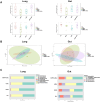A Lactobacillus Combination Ameliorates Lung Inflammation in an Elastase/LPS-induced Mouse Model of Chronic Obstructive Pulmonary Disease
- PMID: 38865030
- PMCID: PMC12532766
- DOI: 10.1007/s12602-024-10300-9
A Lactobacillus Combination Ameliorates Lung Inflammation in an Elastase/LPS-induced Mouse Model of Chronic Obstructive Pulmonary Disease
Abstract
Chronic obstructive pulmonary disease (COPD) is the world's leading lung disease and lacks effective and specific clinical strategies. Probiotics are increasingly used to support the improvement of the course of inflammatory diseases. In this study, we evaluated the potential of a lactic acid bacteria (LAB) combination containing Limosilactobacillus reuteri GMNL-89 and Lacticaseibacillus paracasei GMNL-133 to decrease lung inflammation and emphysema in a COPD mouse model. This model was induced by intranasal stimulation with elastase and LPS for 4 weeks, followed by 2 weeks of oral LAB administration. The results showed that the LAB combination decreased lung emphysema and reduced inflammatory cytokines (IL-1β, IL-6, TNF-α) in the lung tissue of COPD mice. Microbiome analysis revealed that Bifidobacterium and Akkermansia muciniphila, reduced in the gut of COPD mice, could be restored after LAB treatment. Microbial α-diversity in the lungs decreased in COPD mice but was reversed after LAB administration, which also increased the relative abundance of Candidatus arthromitus in the gut and decreased Burkholderia in the lungs. Furthermore, LAB-treated COPD mice exhibited increased levels of short-chain fatty acids, specifically acetic acid and propionic acid, in the cecum. Additionally, pulmonary emphysema and inflammation negatively correlated with C. arthromitus and Adlercreutzia levels. In conclusion, the combination of L. reuteri GMNL-89 and L. paracasei GMNL-133 demonstrates beneficial effects on pulmonary emphysema and inflammation in experimental COPD mice, correlating with changes in gut and lung microbiota, and providing a potential strategy for future adjuvant therapy.
Keywords: Lactobacillus; COPD; Gut microbiota; Gut-lung axis; Short chain fatty acids.
© 2024. The Author(s).
Conflict of interest statement
Declarations. Conflict of Interest: The authors have declared that no competing interest exists. Ethical Statements: There was no involvement of human subjects in this study. Protocols of animal experiments were reviewed and approved by the IACUC Laboratory Animal Center of GenMont Biotech Incorporation with the approval number as 110,009.
Figures







References
-
- Hogg JC, Chu F, Utokaparch S et al (2004) The nature of small-airway obstruction in chronic obstructive pulmonary disease. N Engl J Med 350(26):2645–2653. 10.1056/NEJMoa032158 - PubMed
-
- Corlateanu A, Covantev S, Mathioudakis AG, Botnaru V, Siafakas N (2016) Prevalence and burden of comorbidities in chronic obstructive pulmonary disease. Respir Investig 54(6):387–396. 10.1016/j.resinv.2016.07.001 - PubMed
-
- Wang C, Xu J, Yang L et al (2018) Prevalence and risk factors of chronic obstructive pulmonary disease in China (the China Pulmonary Health [CPH] study): a national cross-sectional study. Lancet 391(10131):1706–1717. 10.1016/s0140-6736(18)30841-9 - PubMed
-
- Halpin DMG, Criner GJ, Papi A, Singh D, Anzueto A, Martinez FJ, Agusti AA, Vogelmeier CF (2021) Global initiative for the diagnosis, management, and prevention of chronic obstructive lung disease. The, 2020 GOLD science committee report on COVID-19 and chronic obstructive pulmonary disease. Am J Respir Crit Care Med 203(1):24–36. 10.1164/rccm.202009-3533SO - PMC - PubMed
MeSH terms
Substances
Grants and funding
LinkOut - more resources
Full Text Sources
Medical
Miscellaneous

